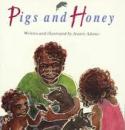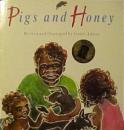AustLit
Latest Issues
AbstractHistoryArchive Description
Publication Details of Only Known VersionEarliest 2 Known Versions of
Other Formats
- Also braille, sound recording.
Works about this Work
-
Indigenous Language Publishing - Black Ink Press
2012
single work
column
— Appears in: Our Languages Are the Voice of the Land : the FATSIL Newsletter , January vol. 44 no. 2012;'Black Ink Press is a community-based Indigenous publishing company based in North Queensland, specialising in contemporary illustrated books for young readers. Black Ink Press has a strong commitment to publishing in Indigenous languages.'
'So far, Black Ink has published in Gudjal, Mamu, Mitakoodi, Gamilaraay, Wadja, Wik Mungkan, Wiradjuri, Kalaw Kawaw Ya, Torres Strait Creole and Nywaigi. They have new books in Kunjen and Djambarpuyingu, and are developing projects in Warrgamay, Yidinj, Waluwara, and others. Some of these only have a few words ‘in language’ but they do give readers a taste. Others are fully bi-lingual.' (Abstract)
-
Spreading the Seeds : Australian Indigenous Publishing for Young People
2009
single work
essay
— Appears in: Magpies : Talking About Books for Children , May vol. 24 no. 2 2009; (p. 8-12)Sheahan-Bright explores '...the growth in publishing by Indigenous writers and publishers, and of writing on Indigenous cultural themes, and some of the issues which confront publishers when dealing with Indigenous writers and illustrators' (8). The article begins with some background, and points out that despite a cultural and artistic heritage that dates back thousands of years, Indigenous writing and publishing has not been widely recognised in mainstream Australian until most recently and Sheahan-Bright says "This is despite their having been engaged in colonial conflict and later subject to the...assimilation policies which discouraged involvement with European notions of literacy" (8). She discusses the origins of the Indigenous publishing houses Aboriginal Studies Press (ASP), Institute of Aboriginal Development (IAD Press), Magabala Books, Keeaira Press, Black Ink Press, Indij Readers and briefly refers to the above mentioned texts in the section entitled 'what's being published'. This leads into a summary of the five main issues in relation to Indigenous publishing and the 'need for authenticity in writing about Indigenous peoples and culture' (11). Sheahan-Bright lists these issues as 'respect for country and Indigenous control of material', relevance of copyright issues, lack of understanding from non-Indigenous Australians, the need to consider 'protocol, specific authority, appropriation' and finally, to develop an awareness of the social factors that contribute to the socially and economically disadvantaged position of the majority of Indigenous Australians. She argues that 'knowledge of Indigenous culture is a genuine part of Australian culture ...and the publishing output should reflect that' (12). However, she concludes that while 'there has been growth in publishing Indigenous voices in English', in general, 'there are many miles still to be travelled and many seeds still to be sown' (12)
-
Voices in My Place and Pigs and Honey
1993
single work
criticism
— Appears in: Australian Children's Literature : Finding a Voice 1993; (p. 1-17) Bunbury isolates and deconstructs the many voices in the texts My Place and Pigs and Honey. -
Book Reviews
1992
single work
essay
— Appears in: Australian Aboriginal Studies , no. 1 1992; (p. 95-97)These four books are undeniably Aboriginal in nature and are all important books but there the similarities end. They present three different perspectives. The Legend of the Seven Sisters and Wunambi are traditional stories from Western Australia written by May O'Brien and illustrated by Sue Wyatt with a definite educational purpose. Pigs and Honey, written and illustrated by a non-Aboriginal person, Jeanie Adams, gives an insight into the life of the Aurukun community on Cape York Peninsula in Far North Queensland. The Story of the Falling Star is not only a traditional story but also a story about the Paakantji people and their land in the Darling River area of New South Wales. It is told by one of their own people, Elsie Jones, in collaboration with the Western Regional Aboriginal Land Council.' (Introduction)
-
Know the Author/Illustrator : Jeanie Adams
1990
single work
column
— Appears in: Magpies : Talking About Books for Children , May vol. 5 no. 2 1990; (p. 13-15)
-
Untitled
1990
single work
review
— Appears in: Magpies : Talking About Books for Children , March vol. 5 no. 1 1990; (p. 30)
— Review of Pigs and Honey 1989 single work picture book -
CBC Awards 1990
1990
single work
review
— Appears in: The Canberra Times , 28 July 1990; (p. B8)
— Review of Pigs and Honey 1989 single work picture book -
Pick of the Bunch For Kids
1990
single work
review
— Appears in: The Sydney Morning Herald , 21 March 1990;
— Review of Pigs and Honey 1989 single work picture book ; The Red King 1989 single work novel -
No Roos or Taboos : We've Come of Age
1990
single work
review
— Appears in: The Australian Magazine , 24-25 March 1990;
— Review of Pigs and Honey 1989 single work picture book ; The Dragon of Mith 1989 single work children's fiction -
Picturing life in books for children
1989
single work
review
— Appears in: The Advertiser , 22 July 1989;
— Review of Pigs and Honey 1989 single work picture book -
Know the Author/Illustrator : Jeanie Adams
1990
single work
column
— Appears in: Magpies : Talking About Books for Children , May vol. 5 no. 2 1990; (p. 13-15) -
Spreading the Seeds : Australian Indigenous Publishing for Young People
2009
single work
essay
— Appears in: Magpies : Talking About Books for Children , May vol. 24 no. 2 2009; (p. 8-12)Sheahan-Bright explores '...the growth in publishing by Indigenous writers and publishers, and of writing on Indigenous cultural themes, and some of the issues which confront publishers when dealing with Indigenous writers and illustrators' (8). The article begins with some background, and points out that despite a cultural and artistic heritage that dates back thousands of years, Indigenous writing and publishing has not been widely recognised in mainstream Australian until most recently and Sheahan-Bright says "This is despite their having been engaged in colonial conflict and later subject to the...assimilation policies which discouraged involvement with European notions of literacy" (8). She discusses the origins of the Indigenous publishing houses Aboriginal Studies Press (ASP), Institute of Aboriginal Development (IAD Press), Magabala Books, Keeaira Press, Black Ink Press, Indij Readers and briefly refers to the above mentioned texts in the section entitled 'what's being published'. This leads into a summary of the five main issues in relation to Indigenous publishing and the 'need for authenticity in writing about Indigenous peoples and culture' (11). Sheahan-Bright lists these issues as 'respect for country and Indigenous control of material', relevance of copyright issues, lack of understanding from non-Indigenous Australians, the need to consider 'protocol, specific authority, appropriation' and finally, to develop an awareness of the social factors that contribute to the socially and economically disadvantaged position of the majority of Indigenous Australians. She argues that 'knowledge of Indigenous culture is a genuine part of Australian culture ...and the publishing output should reflect that' (12). However, she concludes that while 'there has been growth in publishing Indigenous voices in English', in general, 'there are many miles still to be travelled and many seeds still to be sown' (12)
-
Voices in My Place and Pigs and Honey
1993
single work
criticism
— Appears in: Australian Children's Literature : Finding a Voice 1993; (p. 1-17) Bunbury isolates and deconstructs the many voices in the texts My Place and Pigs and Honey. -
The Children's Book Council of Australia Awards, 1990 Acceptance Speeches : Jeanie Adams
1990
single work
column
— Appears in: Reading Time : The Journal of the Children's Book Council of Australia , vol. 34 no. 4 1990; (p. 4) -
Indigenous Language Publishing - Black Ink Press
2012
single work
column
— Appears in: Our Languages Are the Voice of the Land : the FATSIL Newsletter , January vol. 44 no. 2012;'Black Ink Press is a community-based Indigenous publishing company based in North Queensland, specialising in contemporary illustrated books for young readers. Black Ink Press has a strong commitment to publishing in Indigenous languages.'
'So far, Black Ink has published in Gudjal, Mamu, Mitakoodi, Gamilaraay, Wadja, Wik Mungkan, Wiradjuri, Kalaw Kawaw Ya, Torres Strait Creole and Nywaigi. They have new books in Kunjen and Djambarpuyingu, and are developing projects in Warrgamay, Yidinj, Waluwara, and others. Some of these only have a few words ‘in language’ but they do give readers a taste. Others are fully bi-lingual.' (Abstract)
Awards
- 1990 CBCA Book of the Year Awards — CBCA Award for New Illustrator — New Illustrators
- 1990 winner CBCA Book of the Year Awards — Book of the Year: Younger Readers
- Aurukun, Aurukun - Bamaga area, Cape York Peninsula, Queensland,





